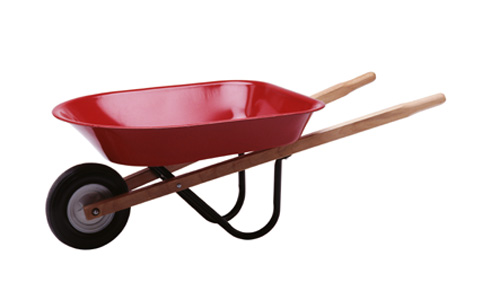Lever, << LEHV uhr or LEE vuhr, >> is one of the six simple machines for performing work. It consists of a rod or bar that rests and turns on a support called a fulcrum. A force of effort is applied at one end of the rod to lift a load placed at the other end. The distance between the fulcrum and the load is the load arm. The distance from the fulcrum to the applied force is the effort arm. A lever can help lift a weight with less effort. Prying something loose with a crowbar is using a lever. Some machines, such as a catapult, use a lever to hurl objects.
Classes of levers
First-class levers
have the fulcrum placed between the load and the effort, as in the seesaw, crowbar, and balance scale. If the two arms of the lever are of equal length, the effort must be equal to the load. To lift 10 pounds, an effort of 10 pounds must be used. If the effort arm is longer than the load arm, as in the crowbar, the effort travels farther and is less than the load. A pair of scissors is a double lever of the first class.
Second-class levers
have the load between the effort and the fulcrum. A wheelbarrow is a second-class lever. The axle of the wheel is the fulcrum, the handles take the effort, and the load is placed between them. The effort travels a greater distance and is less than the load. A nutcracker is a double lever of this class.

Third-class levers
have the effort placed between the load and the fulcrum. The effort always travels a shorter distance and must be greater than the load. The forearm is a third-class lever. The hand holding the weight is lifted by the biceps muscle of the upper arm which is attached to the forearm near the elbow. The elbow joint is the fulcrum.
Compound levers
combine two or more levers, usually to decrease the effort. By applying the principle of the compound lever, a person could use the weight of one hand to balance a load weighing a ton.
Law of equilibrium
A lever is in equilibrium when the effort and the load balance each other. The law of equilibrium is:
The effort multiplied by the length of the effort arm equals the load multiplied by the length of the load arm.
Let L be the load, E the effort, e the effort arm, and w the load arm. The law of equilibrium may be stated in a mathematical formula: L is to e as E is to w, or E*e = L*w
To see how the formula works, imagine two children sitting on a seesaw. One child weighs 400 newtons and sits 1.5 meters from the fulcrum. Where must the other child sit to balance the seesaw if the other child weighs 300 newtons? Let the first child equal the load, L, and the second child the effort, E. 
Another example of a first-class lever is that of a person lifting a 300-pound stone with a 6-foot crowbar. The stone is 1 foot from the fulcrum. The person then pushes down on the crowbar 5 feet from the fulcrum. So, E X 5 feet = 300 pound X 1 foot; or E = 60 pounds, the force needed to balance the stone.
This law of equilibrium is true for all classes of levers. A force multiplied by its lever arm is called a moment of force, or torque. The law of levers may be stated simply by saying that the moment of the lifting force must equal the moment of the force due to the load.
The mechanical advantage of a lever tells how many pounds of load can be moved by each pound of effort. It can be calculated by dividing the load by the effort or the length of the effort arm by the length of the load arm. In the crowbar example above, the mechanical advantage is 5, that is, 300 pounds divided by 60 pounds, or 5 feet divided by 1 foot.
